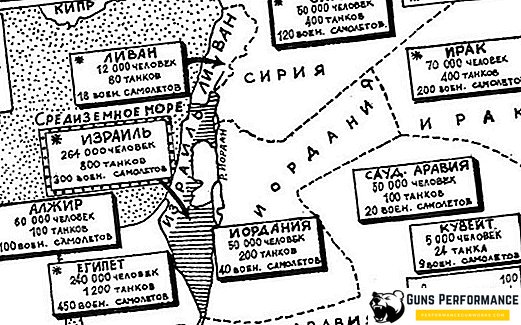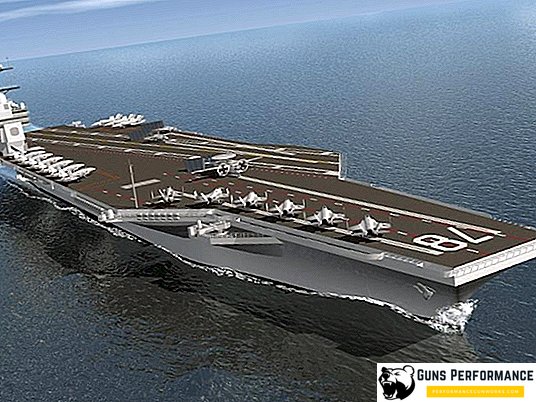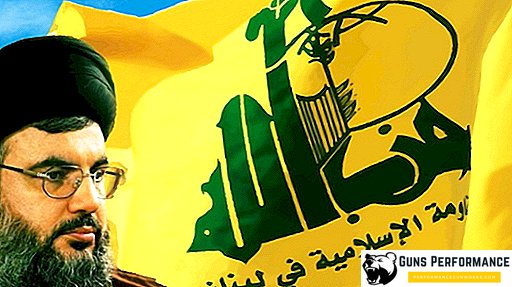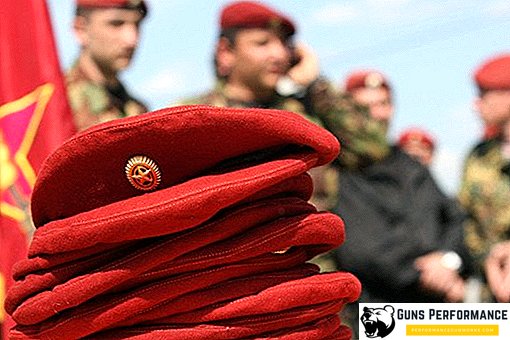After World War II, it became clear that the old tactics used by the countries of the world since the beginning of the 20th century are completely unsuitable for use in modern wars. The rapid development of aviation and armored vehicles, as well as the principles of their interaction, verified and verified during the largest conflict of the 20th century, formed a new doctrine. This doctrine was most successfully used by Israel in the so-called Six-Day War of 1967.
Background and causes of the Six Day War
The history of modern Arab-Israeli relations dates back to 1948, when the state of Israel was formed. The formation of this state caused great discontent among the Arab population of Palestine, as well as Syria and Egypt, who had views of these lands and wanted to have their allies on them. It is for this purpose that the Arab neighbors of Israel began hostilities with the goal of seizing territory (the actual fighting began in 1947; in 1948 they assumed the character of war against the Jewish state). However, the victory of Israel in the war did not allow the Arabs to "solve the Jewish question" even then.

The Suez crisis and short-term war significantly increased the hostility between Israel and Egypt, which were the opposing sides in this conflict. Another important consequence was the distancing of Egypt from Western countries and the rapprochement with the USSR, which provided the country with substantial economic assistance. At the same time, Egypt was moving closer to Syria, as well as a number of other Arab states. In November 1966, Egypt and Syria signed an agreement on military alliance between the two countries.
During the first half of the 1960s, Egypt’s relations with Israel somewhat stabilized, and soon the tension between the countries almost ceased.
However, relations between Israel and Syria were rapidly deteriorating. There were several reasons for the conflict. The first and perhaps most important was the problem of water resources. After the signing of the truce in 1949, the mouth of the Jordan River turned out to be on the territory of the demilitarized zone between the two countries. This river fed Lake Kinneret, which was partly located in Israel and had a serious impact on the economic and economic life of the state. Syria's work on changing the bed of the Jordan River in order to divert its water from the lake caused a fierce border conflict, culminating in the victory of Israel. The second reason was the desire of both countries to gain complete control over the demilitarized zone, which was also often splashed into border incidents. The third reason was that Syria supported the Arab partisans in Israel, including the Palestine Liberation Organization (PLO). Armed clashes on the Syrian-Israeli border in early 1967 became more frequent, sometimes developing into full-fledged military operations with the use of tanks, aircraft and artillery.
In May 1967, Egypt warned the USSR that Israel was preparing a war against Syria, for which he concentrated from 10 to 13 brigades on the Syrian border. In this regard, the Egyptian leadership was forced to begin the mobilization and concentration of troops on Sinai, on the Israeli border. These measures were to have deterrent measures for Israel.
In response to mobilization in Egypt and Syria, mobilization was launched in Israel. Following this, the mobilization of the beginning and Jordan, also not distinguished by sympathy in Israel. Also Algeria joined the coalition against Israel, sending its troops to Egypt, to the Sinai Peninsula, Sudan and Iraq, which moved troops to Jordan. Thus, the overall picture of the upcoming conflict was almost formed. Israel was to fight essentially against the hostile states that surrounded it.
At the same time, at the insistence of the Egyptian leadership, the UN peacekeeping forces were withdrawn from the Sinai zone, and by the beginning of June the Israeli border was almost completely open. Now the conflict was almost inevitable.
The war became a fact (June 5, 1967)

By the morning of June 5, 1967, it became clear to the Israeli leadership that the war would begin in the coming days, if not hours. This was confirmed by the beginning of the attacks of the Egyptian troops on the Sinai Front. If the troops of the Arab countries struck a simultaneous attack on Israel from all sides, the consequences for it would be most dire because of the absolute impossibility of repelling an invasion on all fronts at the same time.
In order to get ahead of the enemy and inflict a preemptive strike on him, as well as to neutralize his aircraft if possible, the Israeli Air Force, with the approval of Defense Minister Moshe Dayan (one of the authors of the Israeli doctrine of the modern blitzkrieg), conducted Moked. This operation was directed against the Egyptian Air Force. The first wave of attack aircraft "Mirage" went on a mission at 7 am Israeli time. As early as 7:45, they suddenly attacked a number of Egyptian airfields, using special concrete bombs to disable their runways. After that, powerful air strikes were made directly on Egyptian aviation, as a result of which, by the end of June 5, Egyptian losses in aviation amounted to about 420 cars, and Israel - only 20.

At about 11 am, Israeli airfields and military installations began to be subject to air raids by aviation in Jordan, Syria, and Iraq. However, on the same day, the strikes were also inflicted on their airfields, while the losses in aviation were also significantly higher than the Israeli ones. Thus, on the very first day, Israel essentially captured air superiority, which was an important component of the new military doctrine. As early as June 5, the countries of the anti-Israeli coalition practically had no opportunity to attack Israel, since the absence of reliable air cover made this completely impossible.
However, on the Sinai Front, on June 5, fighting began between the Egyptian and Israeli forces. Here from the Israeli side were concentrated 14 brigades, which during the first half of the day successfully restrained Egyptian pressure. Then the Israeli offensive began in Gaza, as well as to the west through the Sinai Peninsula. Here it was planned to go with lightning speed to the Suez Canal along the shortest path and cut off the parts located in the south of the peninsula from the rest of Egypt.
At the same time, fighting broke out in Jerusalem itself. Here the Arab legion entered the battle, using mortars to attack the western, Israeli part of the city. In this regard, three brigades were sent to the Israeli garrison in Jerusalem, which rather quickly turned the tide in their favor. By the end of June 5, the Israeli paratroopers managed to get through to the Old City, knocking the Arabs out of their territory.
On the Syrian front, in the area of the Golan Heights, there were no major changes. On the first day of the battles, the sides exchanged only artillery strikes.
The development of hostilities (June 6-8, 1967)

By 12 o'clock for June 6, 1967, on the Sinai front, the Israeli forces were able to completely seize Gaza and allocate additional troops for a rush to Suez. At this time, battles were already under way for Rafah and El-Arish, which were taken by the end of the day. Also in the center of Sinai, on June 6, the 2nd Egyptian Motorized Infantry Division was surrounded and defeated. As a result, a gap was formed here, into which the tank units of Israel rushed, soon confronted here with resistance from the 3rd Egypt Infantry Division.
At the same time, part of the Israeli tank forces operating on the Sinai Front, turned to the south-west in order to cut off the Egyptian forces operating in the south of the peninsula and began to withdraw to the west due to the rapid advance of the Israelis. The advancing Israeli forces were supported by aviation, inflicting airstrikes on the most vulnerable Egyptian troops that were retreating from that. Thus, on June 6, Israel’s victory in the Sinai Peninsula became apparent.
On the Jordanian front, the events of June 6 were marked by the complete encirclement of the Old City in Jerusalem. Here, Israel’s tank units occupied Ramallah in the north and Latrun in the south. However, on June 6, the Old Town itself was not taken by storm: Arab troops put up fierce resistance, causing serious losses to Israeli units.
On the Syrian front, the day of June 6, like the previous one, was not marked by serious changes in the situation. Artillery firefights continued until the morning of June 9, and neither side attempted to seize the initiative.
Also on June 6, the only sea battle of the Six Day War took place. An Egyptian missile boat was found near Port Said by the Israeli navy, which intensified offensive patrols in the Suez Canal area. As a result, the boat was sunk by the Israeli destroyer "Yafo".
On June 7, Israeli forces occupied the settlements of Bir-Gifgaf and Rumani on the Sinaisk Front, with practically no resistance from the Egyptian troops. Only in the central part of the front one of the Israeli tank brigades stopped due to lack of fuel and was subsequently surrounded by superior Egyptian forces. However, the Egyptian forces did not succeed in destroying this brigade due to the need to withdraw troops to the Suez Canal and to quickly advance Israeli units.

In the region of Sharm el-Sheikh, with the goal of speedy capture of the city, an Israeli airborne assault force landed, which advanced north-west along the coast of the Gulf of Suez to join the mobile Israeli forces that completed the cutting off of Egyptian troops in the southeast of the peninsula.
On the Jordanian front, as a result of an intense assault, the Old City of Jerusalem was taken by Israeli troops. On the same day, the cities of Bethlehem and Gush Etzion were also taken. By this time almost the entire territory of Palestine was already under the control of the Israeli troops. After this, the defeat of the anti-Israeli forces on this front became predetermined. However, the Israeli troops suffered serious losses, which is why they were absolutely not interested in continuing the bloodshed. As a result, already at 8 pm on June 7, both parties accepted the proposal of the UN Security Council on a cease-fire.
On June 8, 1967, Israeli troops on the Sinai front continued to advance deep into Egyptian territory. In the north, they managed to reach the Suez Canal, after which they stopped. In the central sector of the front, Israeli forces managed to drop the Egyptian units and unlock the tank brigade surrounded on June 7. In the south, the Israeli air assault force linked up with mobile units that went through all of Sinai and continued to move north to the Suez Canal. By the end of June 8, almost the entire Sinai Peninsula was in the hands of the armed forces of Israel, and its tank and motorized units reached the Suez Canal almost throughout its length.
The end of the war and the truce (June 9 - 10, 1967)
From the first day of the Arab-Israeli war, the UN Security Council began its work. The task was to immediately stop the bloodshed in the Middle East and return the parties to the negotiating table. However, in the early days, when the victorious moods in the Arab countries were quite high, it was almost impossible to do so. Additional inconvenience caused and the fact that the parties from the first days were firmly drawn into the battle, the purpose of which was to inflict maximum damage to the enemy.
Nevertheless, the first fruits of efforts to stabilize the situation appeared on the third day of the fighting, June 7. On this day, a truce was concluded on the Jordan Front, where the fighting between the Israeli forces and the armed forces of Jordan, Iraq and the Arab legion ceased.
On June 9, 1967, the UN Security Council’s proposal for a cease-fire was accepted by Israeli forces on the Sinai Front. By this time, Israel had achieved a complete military victory, while not intending to move further west. Egyptian troops ceased firing only the next day, June 10th.

On the Syrian front in the area of the Golan Heights, on June 9, Israeli troops suddenly in the morning suddenly launched an offensive for the enemy. At the same time, if during the day the Syrian troops managed to restrain the Israelis, by the night the pressure increased, and the Syrian defense was broken. At the same time, other parts of Israel made their way north of Kineret Lake, bypassing the Syrian troops that fought on the Golan Heights, from the flank. As a result, by June 10, Syrian troops here were driven out to the northeast and the large city of Quneitra was taken. At 19:30 pm, a cease-fire agreement also entered into force on the Syrian front.
Thus, after the conclusion of a truce on all fronts, the war of the Arab states against Israel essentially came to an end.
Loss sides
According to the generalized data, the losses of the Arab states in the course of the Six Day War amount to 13 to 18 thousand people killed, about 25 thousand wounded and about 8 thousand prisoners, 900 units of armored vehicles and about 500 aircraft. Of these losses, Egypt accounts for the main part - 12 thousand dead, 20 thousand wounded and 6 thousand prisoners. Iraq suffered the smallest casualties - about 10 killed and 30 wounded.
The losses of Israel are significantly lower than the losses of the Arab coalition and range from 800 to 1 thousand people, 394 armored vehicles and 47 airplanes.
Results and outcomes of the Six Day War

As a result of the conflict in six days, Israel inflicted a crushing defeat on the countries of the Arab coalition. The air forces of Egypt, Jordan and Syria were almost destroyed, as a result of which these countries had to spend huge amounts of money to restore them. Also, the huge losses of military equipment in general led to the loss of combat capability by the armies of Arab states.
The Soviet leadership was finally entrenched in the thought that the USSR did not have powerful allies in the Middle East. The enormous funds allocated by the Soviet Union to the armaments of Arab countries, the training of their military personnel and the provision of economic assistance in fact did not bear fruit. In the context of these events, the reorientation of the new Egyptian President Anwar Sadat to the United States in 1970 looked very sad.
At the same time, Israel failed to solve all its foreign policy problems. In August 1967, a conference of Arab leaders was held in the Sudanese capital, Khartoum. At this meeting, the principle of a triple "no" was adopted: "no" - peace with Israel, "no" - negotiations with Israel, "no" - recognition of Israel. A new stage of armament of neighboring Arab states has begun. Thus, Israel’s military victory did not exclude future military conflicts with Arab states, which was proved as early as 1968, when Egypt began hostilities against Israel in order to win back the occupied territories and get revenge for a humiliating defeat. However, after the Six Day War, Israel did not stop preparing for new fighting.
Like any conflict, the Six Day War was accompanied by a major humanitarian disaster. Tens of thousands of Arabs were forced to flee from Palestine and from the Old City of Jerusalem to neighboring countries, fleeing persecution from the Jews.
The 1967 Arab-Israeli conflict was in essence the triumph of the military doctrine called by a number of military analysts the “modern blitzkrieg”. A sudden air raid on enemy airfields, neutralization of enemy air forces, close interaction of tank units with aircraft, landings in the rear of the enemy - all this has already been revealed to the world, but for the first time with the use of modern weapons. Until now, throughout the world, the history of the Six-Day War has been studied as one of the most brilliant in its design and operations to seize the initiative and defeat against several opponents, whose total strength exceeds their own.
Despite the fact that this year marks the 50th anniversary of the Six Day War, this conflict will be remembered for a long time not only in Israel, but also in the Arab countries that took part in it.












